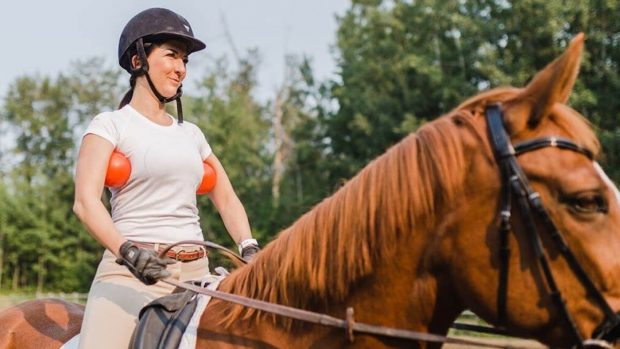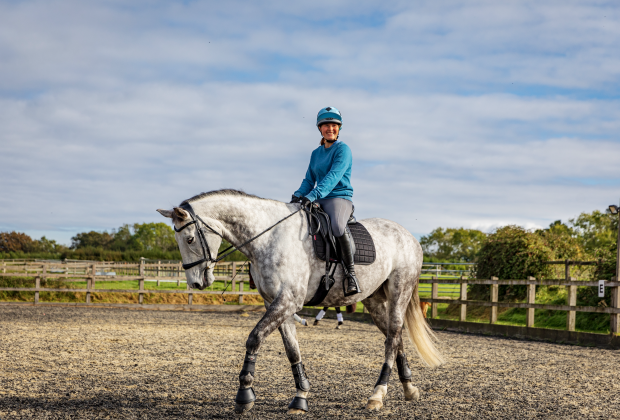Since my last blog, a number of my clients have enquired about ways in which they can help their horse to engage and strengthen its hind quarters.
For me, engagement of the hindlimb is the ability to effectively recruit the muscles that produce optimal movement and power regardless of individual conformational traits. This requires not only strength but flexibility and coordination of movement too. The potential amount of engagement is therefore individual to each horse, furthermore, hindlimb engagement really encompasses more than just the hindlimb. It incorporates self-carriage and ‘engagement’ of the entire horse.
In order to engage the hindlimb effectively, the horse needs to be able to flex and lift up through its back, requiring contraction of its core muscles to do so. Essentially you can think of this lifting of the back as creating space for the hindlimb to move further under the body. If the horse can engage and protract (move forward) the hindlimb further under the body, there is a greater potential for force in the ‘push off’ phase of gait. This is turn supports improvements in strength of the muscles that do the pushing!

There are a number of reasons why a horse may be encouraged to work more from behind, for example, to improve power, to achieve higher marks in dressage, improved jumping ability, or even for comfort and to take pressure off the forehand – the hind end is where some of the most powerful muscles are housed so supporting your horse to use them effectively is a no-brainer.
From a physiotherapy perspective, if a horse is working in supple self-carriage, creating power from behind rather than pulling along on the forehand, then it could be argued that there is a reduced risk of pain and/or injury associated with poor posture and poor core stability. Improving horse comfort often gives rise to improvements in performance, which is typically a goal of riders and trainers alike.
How the hindlimb works
As the hindlimb moves forwards during gait, the hip becomes more flexed and the stifle and hock move from into a more extended position in order to make contact with the ground. Once the limb is in contact with the ground, it acts as an inverted strut, with the consequent joint positionings putting tension on some of the long tendons of the lower limb. These tendons have great elastic properties and act as a spring to support power and push off from the ground into the next stride. The powerful gluteal muscles kick into action, extending the hip as the horse travels forward. Of course all of this requires adequate core stability to enable the horse to maintain effective postural control throughout the gait cycle. Because of this, it is really core stability that interests me most as a physiotherapist, particularly in the initial stages of strengthening.

Often (but not always) a desirable trait of dressage horses is to have positive diagonal advanced placement of the hindlimb, more commonly abbreviated to DAP +ve.
For example, trot is classically a two-beat gait, where the hindlimb and forelimb strike the ground in diagonal pairs. With DAP+ve, the hindlimb strikes the ground a fraction of a second before the forelimb. This gives potential for greater ‘push’ from the hind end and thus potentially a bigger more powerful, expressive movement. The conformation of horses used for higher level dressage will generally support their innate ability to engage and protract the limb under the body in comparison to a horse without such conformational traits.
Nevertheless, we can encourage all horses to improve their core strength and ability to strengthen and create power from hindlimb and pelvic musculature.

Engagement of the hindlimb requires activation of the muscles that flex the spine, support caudal rotation of the pelvis about the lumbosacral junction (as if the horse is tucking its bottom underneath it) and also flexion of the hip. This not only benefits horses in their ridden work, but from a physiotherapy perspective, gives rise to benefits in posture and stability of the spine and pelvis whilst potentially reducing the risk of back and pelvic pain that may be associated with weakness.
Example exercises to engage and strengthen core stability and hindlimb musculature
Studies have shown that an increase in ground inclination leads to an increase in hindlimb muscle activity (particularly at walk) and therefore hill work can be considered as a training method for strengthening and engaging the muscles of the hind limb. The horse will naturally take a more forward step with the hindlimb to allow itself greater push up the hill which is reinforced by research that suggests that the hind foot is in contact with the ground for longer on an incline at walk.

Incorporation of ground poles or cavaletti into schooling sessions should encourage the horse to further recruit abdominal musculature in order to stabilise the spine and pelvis for increased limb flexion (over the poles). During the stance phase of each hindlimb, stabilisation via means of abdominal and gluteal co-contraction helps to provide spinal and pelvic stability.
Anecdotally there are lots of ways in which to further engage and strengthen a horse’s core and hindlimb musculature for example, collected and lateral work, rein-back transitions, renvers and travers, however scientific research has yet to be undertaken.

In the human field, plyometric training has shown benefits in improving leg strength which you could argue with horses could be achieved via gymnastic jump training or inclusion of bounce and related distance fences. Cross training is deemed an effective way of achieving overall strength and conditioning and so perhaps we should also think of training horses in this way and that actually, improving overall conditioning through means of varied training (regardless of your riding discipline) may be a valuable way in engaging the core and hind limb most effectively. Food for thought!
Continued below…
Like this? You might also enjoy reading these:
Nina Wareham’s therapy blog: why horses and humans really aren’t that different
It is important to note that some horses will find it difficult to or simply may not be able to fully engage the hindlimb underneath them and there are a multitude of reasons as to why (including conformation, weakness, stiffness, injury, pain). If you have any concerns about your horse or it has a current/previous injury that may be affecting its ability to engage the hindlimb, please seek advice from your veterinarian.
My next blog will look at ground exercises to help your horse improve core strength and flexibility around its neck and back.
Best wishes,
Nina
Chartered physiotherapist and veterinary physiotherapist





